借用繼承
Data visualization is a great way to celebrate our favorite pieces of art as well as reveal connections and ideas that were previously invisible. More importantly, it’s a fun way to connect things we love — visualizing data and kicking up our feet for a movie night. All week, Nightingale is exploring the intersections between data visualization and all kinds of entertainment.
數據可視化是慶祝我們最喜歡的藝術品以及揭示以前不可見的聯系和想法的好方法。 更重要的是,這是連接我們喜歡的事物的一種有趣方式-可視化數據并為電影之夜踢起腳來。 整個晚上,夜鶯都在探索 數據可視化與各種娛樂之間 的 交集 。

A few months ago I was averaging three museum visits a week, and now I can average three virtual visits in an hour, provided I’m graced with a stable internet connection. While jumping from collection to collection, I’ve held a rather critical eye to the digital museum realm. The trick, however, isn’t to search or expect the same experience that an in-person visit would provide, but be open to a new and different one. Similarly, museums should keep the latter in mind when developing their own digital experiences. I’ll explore the various strategies museums use in terms of their online presence while highlighting digital collections and experiences I find especially ‘successful.’ If you’re eager to skip to the experiences themselves, there’s a list and the bottom of the article, and I’ll never know if you just scroll to the end.
幾個月前,我平均每周工作三個館參觀,現在我可以平均在一個小時內三個虛擬訪問,提供我與一個穩定的互聯網連接增光。 從一個收藏到另一個收藏,我對數字博物館領域持相當批判的眼光。 但是,訣竅不是要搜索或期望獲得與親自訪問一樣的體驗,而是要接受新的和不同的體驗。 同樣,博物館在發展自己的數字體驗時也應牢記后者。 我將探討博物館在網上展示方面使用的各種策略,同時重點介紹我認為特別“成功”的數字館藏和體驗。 如果您急于跳到自己的經歷,這里有一個列表和文章的底部,我永遠不會知道您是否滾動到最后。
走向數字化 (Going Digital)
The COVID-19 pandemic has forced museums to reevaluate their strategy from a primarily physical experience into an online one. While digital collections existed long before the novel coronavirus, more and more digital museum content has been surfacing it began. As I will explain later, providing online access to a museum’s collections and data is one thing, but developing a curated experience out of it is another. Unfortunately, it often seems as though museums take an approach that emerges from the physical exhibition, and use a similar structure to express it online. Rather than attempt to reproduce the in-person museum experience into an unequivocal medium, the internet, museums should seek to create experiences unique to the digital realm. Museums should ask themselves what digital tools can be used to display their collection, seeking frameworks and stories beyond an image-based list, or defaulting to an exhibition format. The digital realm has enough unique attributes to be treated separately.
COVID-19大流行迫使博物館重新評估其策略,從最初的物理體驗轉變為在線體驗。 盡管數字收藏品早于新型冠狀病毒存在,但越來越多的數字博物館內容開始浮出水面。 正如我將在后面解釋的那樣,提供對博物館館藏和數據的在線訪問是一回事,而從中開發策展的體驗則是另一回事。 不幸的是,博物館似乎常常采用從實體展覽中出現的方法,并使用類似的結構在網上進行表達。 博物館不應該試圖將現實的博物館體驗復制到明確的媒體(互聯網)上,而應該尋求創造數字領域特有的體驗。 博物館應該問自己:可以使用哪些數字工具來展示其收藏品,在基于圖像的列表之外尋找框架和故事,或者默認使用展覽形式。 數字領域具有足夠的獨特屬性,需要單獨處理。
As I briefly mentioned in a previous article on how data visualization can enhance the museum experience, digitalizing collections is a first and important step toward this end goal. It is much easier to pull new relationships and ideas from your collection if you’re equipped with data visualization tools and therefore the means to experiment freely with collections. While this is possible with a standard excel sheet, it is arguably more difficult and time-consuming to find such relationships, as excel sheets demand more manual work and a lot of uninspiring patience. Digitalization should be embedded in the museum’s strategy from the get-go, outlining the intended purpose of the digital collection.
正如我在上一篇有關數據可視化如何增強博物館體驗的文章中所簡要提到的那樣 ,對館藏進行數字化是實現這一最終目標的第一步,也是重要的一步。 如果您配備了數據可視化工具,那么可以輕松地從集合中獲取新的關系和想法,因此可以自由地嘗試集合。 盡管使用標準excel表格可以做到這一點,但是找到這樣的關系無疑會更加困難和耗時,因為excel表格需要更多的人工工作和很多令人振奮的耐心。 數字化應該從一開始就嵌入到博物館的戰略中,并概述數字收藏的預期目的。
Derby Museums is one example of a museum collective that implemented a digital strategy. Their brainstorming session notes (an image excerpt is featured below) illustrate the benefits of digitalizing collections and the many faces it can take. To review the objectives:
德比博物館 ( Derby Museums)是實施數字策略的博物館集體的一個例子。 他們的集思廣益的會議記錄(下面是圖片摘錄)說明了對館藏進行數字化的好處以及所能拍攝的許多面Kong。 審查目標:
Global accessibility online: can easily search, share and use collections
在線全球可訪問性 :可以輕松地搜索,共享和使用收藏集
Storytelling: create engagement opportunities whether that be in the form of education, apps etc.
講故事 :以教育,應用等形式創造參與機會。
Management of digital assets: keep the collection organize and accounted for, preserving content that risks degradation
數字資產管理 :保持館藏的組織和核算,保留有降級風險的內容
Monetizing collection: can demonstrate the collection’s value or even generate revenue
貨幣化收藏 :可以展示收藏的價值,甚至產生收益
The objectives are made possible by the digital collection, which serves as their linkage and heart.
這些目標是通過數字收藏品實現的,這些收藏品是它們的鏈接和核心。

With that said, museums have established various digital experience tiers while moving online that stem from the online collection. From basic to more elaborated:
話雖如此,博物館在遷移到網上時已經建立了各種數字體驗層,這些層源于在線收藏。 從基本到詳細:
Online digital collections with basic search features: users can explore the digital collections on their own by searching or browsing.
具有基本搜索功能的在線數字館藏:用戶可以通過搜索或瀏覽自行瀏覽數字館藏。
2. Online digital collections with a guided experience: like above, users can explore digital collections on their own, but there are additional features such as color or time period filters for “guided wandering.” These types of search functions group works in a similar fashion that an exhibition would, with the added benefit of being more malleable.
2. 具有指導性體驗的在線數字館藏:像上面一樣,用戶可以自行瀏覽數字館藏,但是還有其他功能,例如用于“引導性游蕩”的顏色或時間段過濾器。 這些類型的搜索功能組的工作方式與展覽類似,但具有更大的延展性。
3. Virtual tours with google or audio tour (a possible intermediary step): users can follow a tour, in an attempt to mirror the in-person experience.
3. 帶有Google或語音導覽的虛擬導覽(可能的中間步驟):用戶可以跟隨導覽,以嘗試親身體驗。
4. Interactive experiences/applications: users can engage and interact with aspects of the collection.
4. 互動體驗/應用程序:用戶可以與館藏的各個方面進行互動。
Each seems to build off of one another: in other words, I have yet to find museums that have made interactive experiences out of their collections but don’t have an online digital collection for viewing. Online digital collections seem to be the groundwork for more elaborate applications. The next two sections will consider online digital collections, then the interactive experiences that can emerge from them.
彼此之間似乎是相互依存的:換句話說,我還沒有找到能夠從其收藏中獲得互動體驗但沒有在線數字收藏的博物館的博物館。 在線數字館藏似乎是更復雜應用程序的基礎。 接下來的兩個部分將考慮在線數字館藏,然后是從中獲得的互動體驗。
在線數字館藏 (Online digital collections)
While there is diversity in the style of online digital collections—from basic search methods to the more creative—the most rudimentary appear like a visual spreadsheet. Apparently, I’m not alone with this impression. In 2015, Mitchel Whitelaw, who works with museums and libraries alike to digitalize and visualize their collections, published an article in Digital Humanities Quarterly called “Generous Interfaces for Digital Cultural Collections,” which argues that:
從基本的搜索方法到更具創造性的在線數字館藏樣式雖然多種多樣,但最基本的看起來就像是可視電子表格。 顯然,我并不孤單。 2015年,與博物館和圖書館等機構合作以對館藏進行數字化和可視化處理的Mitchel Whitelaw在Digital Humanities Quarterly上發表了一篇名為“ 數字文化館藏的慷慨接口 ”的文章,其中指出:
“[…] search, as the dominant interface to our cultural collections, is inadequate. Keyword search is ungenerous: it demands a query, discourages exploration, and withholds more than it provides. This paper argues instead for generous interfaces that better match both the ethos of collecting institutions, and the opportunities of the contemporary web. Generous interfaces provide rich, navigable representations of large digital collections; they invite exploration and support browsing, using overviews to establish context and maintain orientation while revealing detail at multiple scales.”
“ […]作為我們文化收藏的主要接口,搜索是不夠的。 關鍵字搜索是無用的:它需要查詢,不鼓勵探索,并且不提供所提供的更多功能。 相反,本文認為,慷慨的界面可以更好地匹配收集機構的精神和當代網絡的機會。 慷慨的界面可提供大型數字館藏的豐富導航視圖; 他們邀請探索和支持瀏覽,使用概述來建立上下文并保持方向,同時以多個尺度揭示細節。”
To illustrate his first point about keyword searches, I’ve included an image below taken from the website of London’s Victoria & Albert Museum. I invite you to click here to try it out for yourself.
為了說明他關于關鍵字搜索的第一點,我在下面提供了一張圖片,該圖片取自倫敦維多利亞和阿爾伯特博物館的網站。 我邀請您單擊此處親自嘗試。
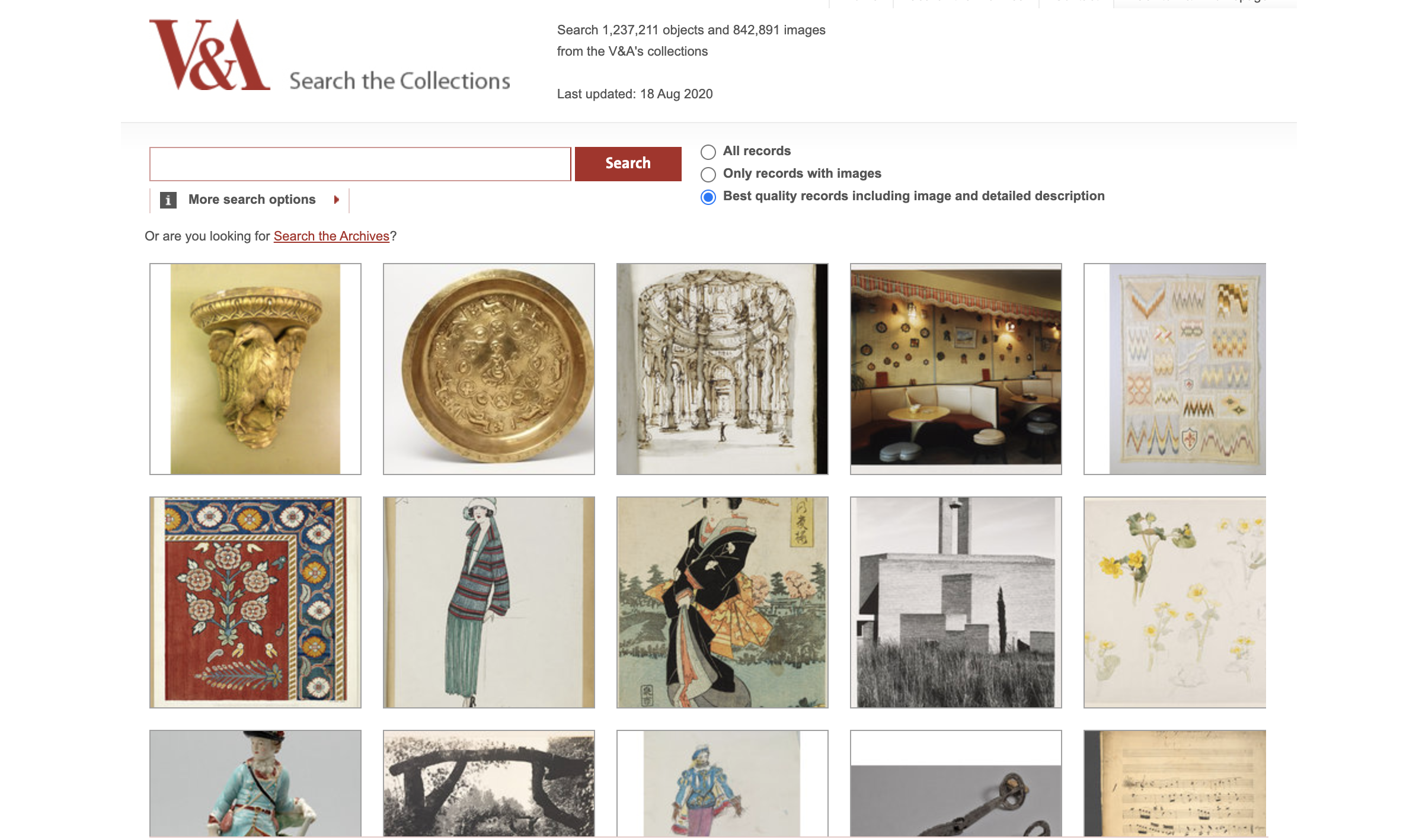
Faced with this landing page, what is your first impression? How would you interact with it? Is there a story that’s being told? While the below interface allows more exploration than a simple keyword search without images, it remains unfriendly for those hoping for guided exploration. You could argue that a loose story thread is fabricated when you type in a search word, but there is no guide or curation involved other than the one you are constructing yourself.
面對著陸頁,您的第一印象是什么? 您將如何與之互動? 有沒有講故事? 盡管與沒有圖像的簡單關鍵字搜索相比,下面的界面可以進行更多的探索,但對于那些希望進行指導探索的人來說仍然不友好。 您可能會爭辯說,輸入搜索詞時會捏造一個松散的故事線索,但是除了您自己構建的那個故事以外,沒有涉及任何指南或策展。
I am not trying to undermine digital collections, I am merely hoping to engage conversation on visualizing and navigating through digital collections to the full extent that current technologies allow. Digital collection interfaces like this one take up only a tiny stroke of what’s possible in the digital landscape.
我并不是要破壞數字館藏,我只是希望就當前技術允許的范圍內的可視化和導航進行對話。 像這樣的數字采集接口僅占用了數字領域中很小的一筆。
This type of interface for collections, therefore, seems better suited for researchers, or those who have an idea of what kind of work they are looking for in a given collection. Nevertheless, other museums have taken the standard digital collection interface and tweaked it, with amusing results.
因此,這種類型的館藏接口似乎更適合研究人員或那些對特定館藏正在尋找何種工作有想法的人。 盡管如此,其他博物館還是采用了標準的數字收藏界面并對其進行了調整,從而獲得了可喜的結果。
One notable example is the Art Institute Chicago that includes a variety of filter features such as color, places, subjects, etc., as illustrated in the picture below. Indeed, customizing search filters by adding a few “non-traditional” options is an easy fix toward a more curated experience out of a standard searchable digital collection, a point I’ll elaborate on in the following section.
一個著名的例子是芝加哥藝術學院 ,其中包括各種濾鏡功能,例如顏色,位置,主題等,如下圖所示。 確實,通過添加一些“非傳統”選項來自定義搜索過濾器很容易解決,從而可以從標準可搜索數字館藏中獲得更豐富的體驗,這一點我將在下一節中詳細說明。

互動體驗 (Interactive Experiences)
After the work of digitalizing collections is complete, a laboratory or playground of opportunity emerges, depending on your perspective. Data can be manipulated, filtered, and ultimately used to tell stories. These are experiences that stem from digital collections and are written in the language of the internet. Some tours have even left Google’s street-view, as used by the Guggenheim, and upgraded to virtual reality. Experiences like VersailleVR: the Palace is yours and The Dawn of Art: a journey through the Chauvet cave attempt to replicate the in-person experience but do so at the full extent of modern-day technology. The caveat is that you need to own a computer and a VR headset.
館藏數字化工作完成后,根據您的觀點,會出現一個實驗室或機會游樂場。 數據可以被操縱,過濾并最終用于講述故事。 這些是從數字館藏中獲得的經驗,是用互聯網語言編寫的。 一些游覽甚至離開了古根海姆(Guggenheim)使用的Google街景,并升級為虛擬現實。 諸如VersailleVR:宮殿就是您的體驗, 而藝術的曙光:穿越Chauvet洞穴的旅程試圖復制親身體驗,但要在現代技術的最大范圍內進行。 需要注意的是,您需要擁有一臺計算機和一臺VR耳機。
With the above exceptions that aim for a literal translation of museum visits, an advantage of interactive museum applications is that they are unique to the digital sphere. A prime example is the British Museum’s The Museum of the World application.
除了上述旨在對博物館參觀進行字面翻譯的例外,交互式博物館應用程序的一個優點是它們對于數字領域是唯一的。 一個典型的例子是大英博物館 的世界博物館應用程序。
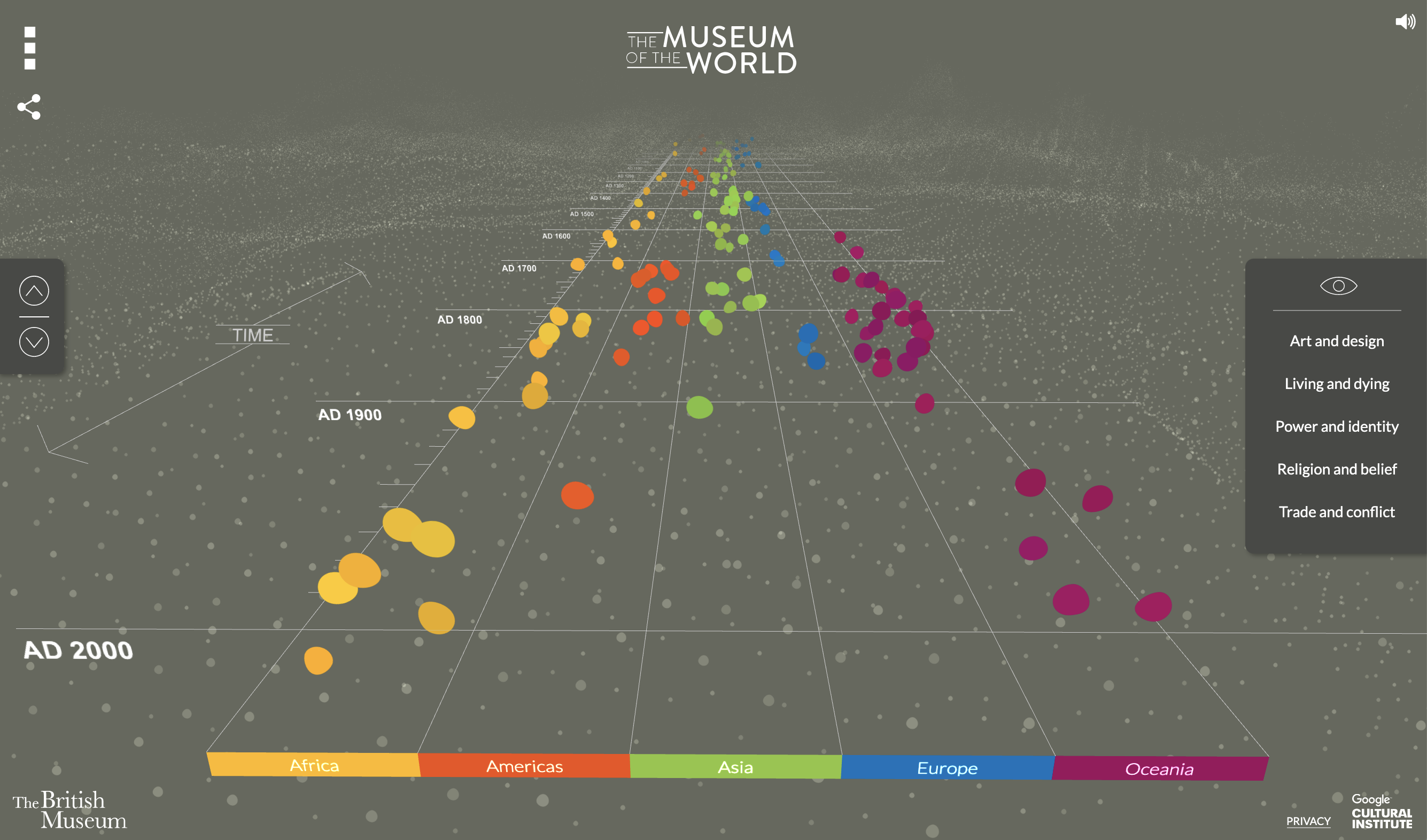
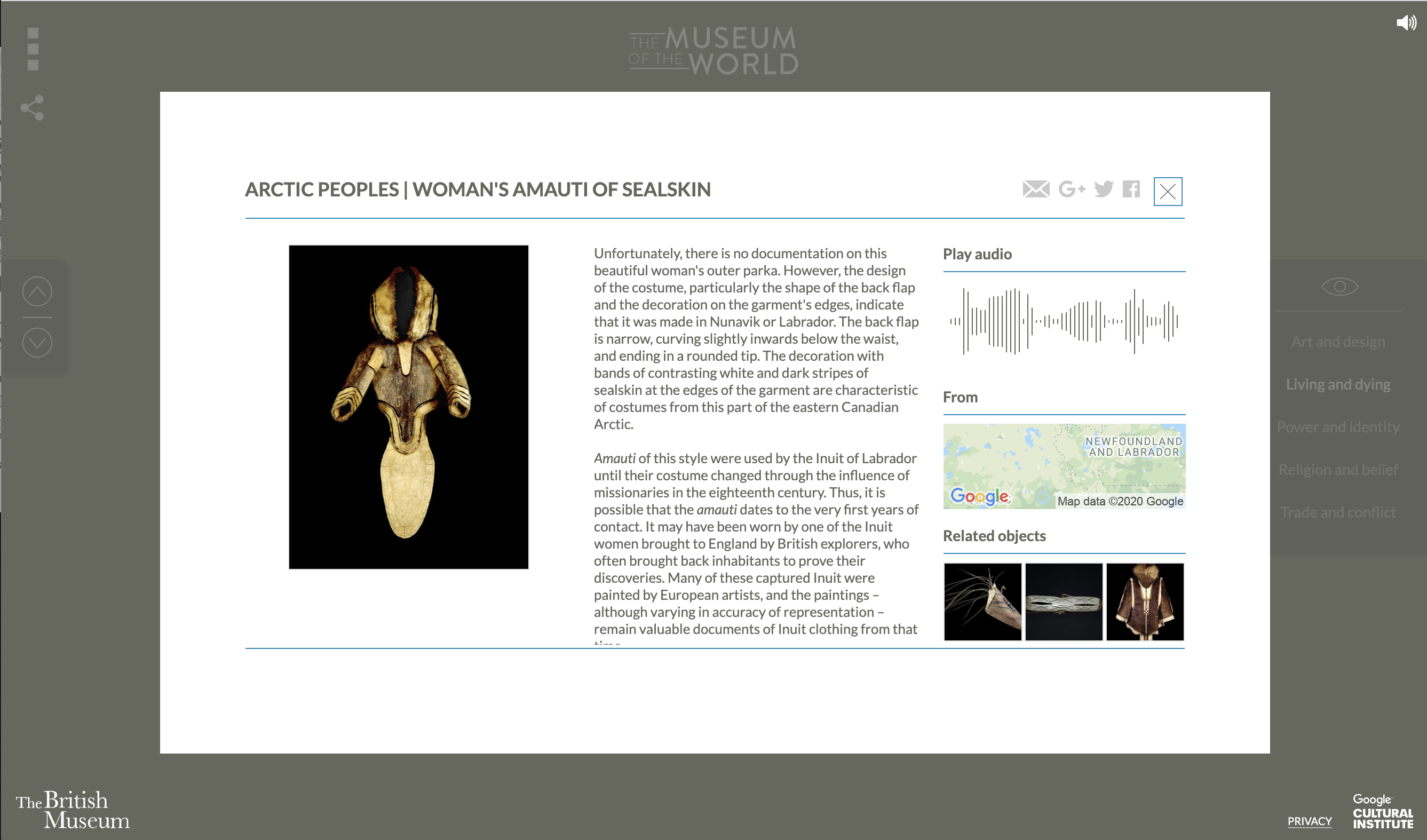
While implementing the standard storytelling thread of chronology, this interactive application allows the user to plunge through time with their mouse or trackpad to click on elements that bring up a multimedia page complete with a description, map of the area in question, audio, and similar objects. Although the whole experience might echo the structure of exhibitions, it is made in the language of the internet with multimedia features that might be lacking in a standard exhibition.
在實現按時間順序排列的標準敘事線程時,此交互式應用程序允許用戶使用鼠標或觸控板在時間上跳入,單擊顯示多媒體頁面的元素,其中包括描述,所關注區域的地圖,音頻等。對象。 盡管整個體驗可能會與展覽的結構相呼應,但它是使用互聯網語言制作的,具有標準展覽可能缺少的多媒體功能。
The Museum of the World is actually a product of Experiments with Google, an initiative that contains a variety of creative programs that artists have outputted using museum collections, going beyond collection lists and virtual tours. It represents an instance of how open-source digital collections can expand digital experiences and spur innovation. I admittedly spent a few hours testing all of the applications on Experiments with Google that piqued my interest. I started with Beyond Scrolls & Screens, which analyzes Japanese folding screens and scrolls in a comic book-like format and at least one of those hours was spent fulfilling my childhood dream of studying hieroglyphics with Fabricius. The beauty lies not only in the interactivity, but Experiments with Google pools together pieces from collections around the world, binding them together in a coherent story.
世界博物館實際上是Google實驗的產物,該計劃包含藝術家創作的各種創意程序,這些程序使用博物館的收藏品進行創作,不僅限于收藏清單和虛擬游覽。 它代表了開源數字館藏如何擴展數字體驗并促進創新的一個實例。 我承認我花了幾個小時在Google的“實驗”上測試了所有應用程序,這激起了我的興趣。 我從Beyond Scrolls&Screens開始,它以類似漫畫的格式分析日式折疊屏風和卷軸,其中至少有一個小時用于實現我童年時與Fabricius學習象形文字的夢想。 美麗之處不僅在于互動性,還有Google的實驗將來自世界各地的收藏品匯集在一起??,將它們捆綁在一起形成一個連貫的故事。
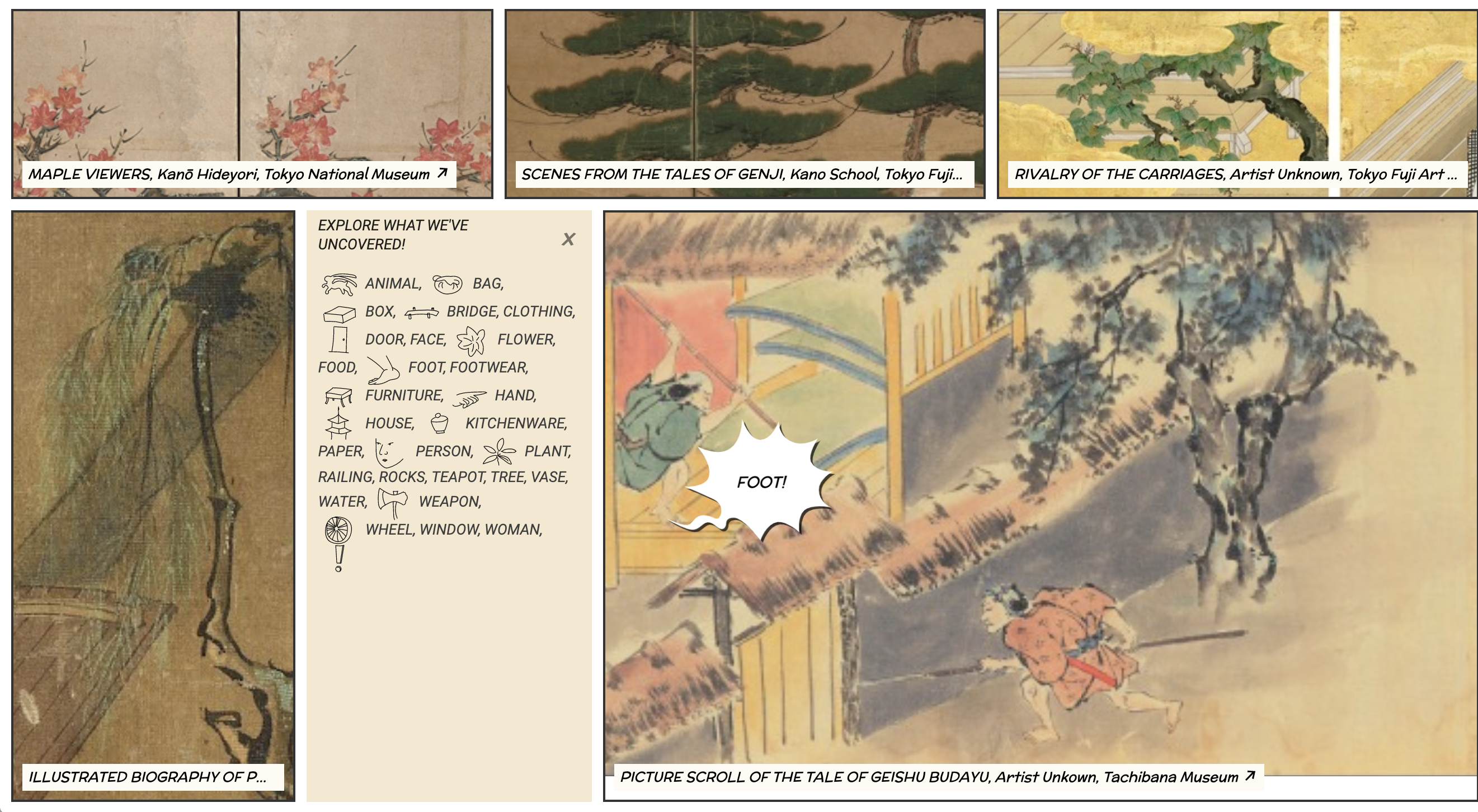
Universities have also produced experimental applications to visualize art. One of my favorites is a collection from the University of Potsdam in Germany. One application, COINS: A journey through a rich cultural collection invites the user to explore historical coins from the Münzkabinett Berlin’s collection.
大學還產生了實驗應用程序以可視化藝術。 我的最愛之一是德國波茨坦大學的收藏 。 一個應用程序, 硬幣:穿越豐富的文化收藏的旅程邀請用戶探索柏林Münzkabinett收藏的歷史硬幣。
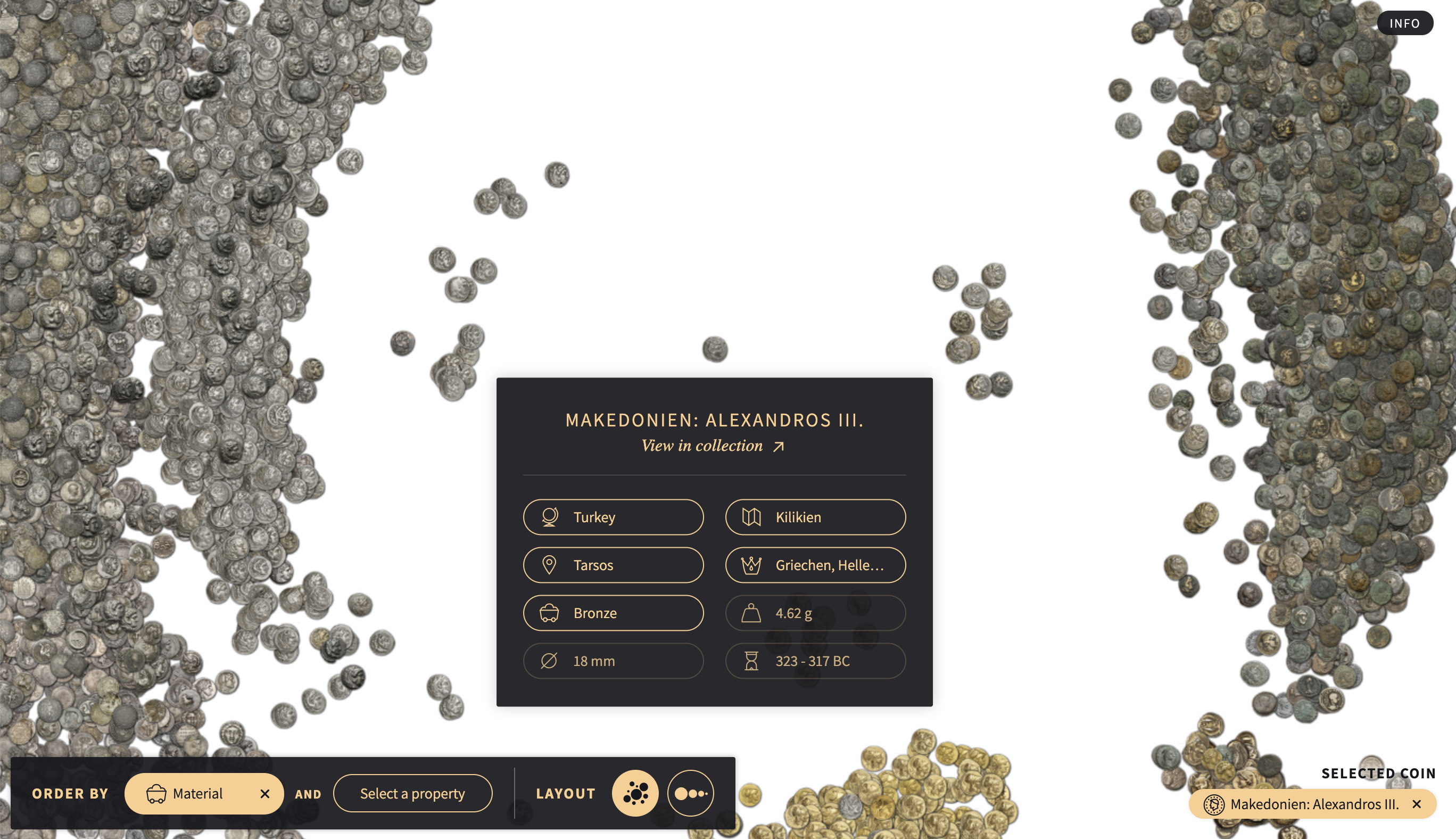
Another hub of experimental art applications is the Library of Congress’s LABS. Their initiatives are quite diverse, including the highly anticipated Citizen DJ, which will produce hip-hop music from the library’s online collection (to be released this summer), and the multi-media story, Southern Mosaic, which documents a trip in 1939 that recorded southern folk music.
實驗藝術應用的另一個中心是國會圖書館的LABS 。 他們的計劃非常多樣化,其中包括備受期待的《 公民DJ》 ,它將通過圖書館在線收藏(將于今年夏天發行)制作嘻哈音樂;以及多媒體故事《 南方馬賽克》 ,記載了1939年的一次旅行,記錄南方民間音樂。

Using recordings of music interwoven with text, photos of the journey, and data visualizations, Southern Mosaic provides a rather holistic exhibition-like experience, with a little something for everyone. Then there’s everything that Jer Thorp did for the Library of Congress, such as A Library of Colors, where mousing over a color triggers a particular piece in the collection.
使用與文本交織的音樂錄音,旅途照片和數據可視化,Southern Mosaic提供了一種相當整體的,類似于展覽的體驗,并且為每個人提供了一些東西。 然后, 杰爾·索普(Jer Thorp)為國會圖書館所做的一切,例如“色彩圖書館” ( A Library of Colors) ,將鼠標懸停在某個色彩上便觸發了該收藏中的特定作品。
This tactic of visualizing collections with color to make interactive pages seems to be a common technique: The Library of Congress has another application, The Library of Congress Colors, where visitors view the color palette of a given collection and each piece within it before being exposed to the work it is referencing. Then there’s Art Palette, from Google Art & Culture, with a similar approach to the latter, but it stems from a given color palette, displaying corresponding pieces, and finally my personal favorite from the Barnes Foundation, which allows users to specify space, lines, and light, in addition to color while filtering through the collection. In the above cases, color is the obvious story thread, though each site has its own emphasis. Look through the following pictures, or try the websites for yourself, and try to notice their differences and how these techniques serve to guide you through the collection. How do these added features change your experience from V&A’s searchable collection?
這種用顏色可視化集合以創建交互式頁面的策略似乎是一種常見的技術:國會圖書館還有另一個應用程序, 即國會圖書館顏色 ,訪問者可以在瀏覽給定集合及其內部的每個部件之前查看其調色板。它正在引用的工作。 然后是Google Art&Culture的Art Palette ,與后者的處理方法類似,但是它來自給定的調色板,顯示了對應的作品,最后是我個人最喜歡的Barnes Foundation ,它允許用戶指定空間,線條,以及光線,以及通過集合過濾時的顏色。 在上述情況下,色彩是顯而易見的故事線索,盡管每個站點都有其自身的重點。 瀏覽以下圖片,或自己嘗試使用網站,并嘗試注意它們之間的差異以及這些技術如何指導您完成收藏。 這些新增功能如何改變V&A可搜索產品系列的體驗?

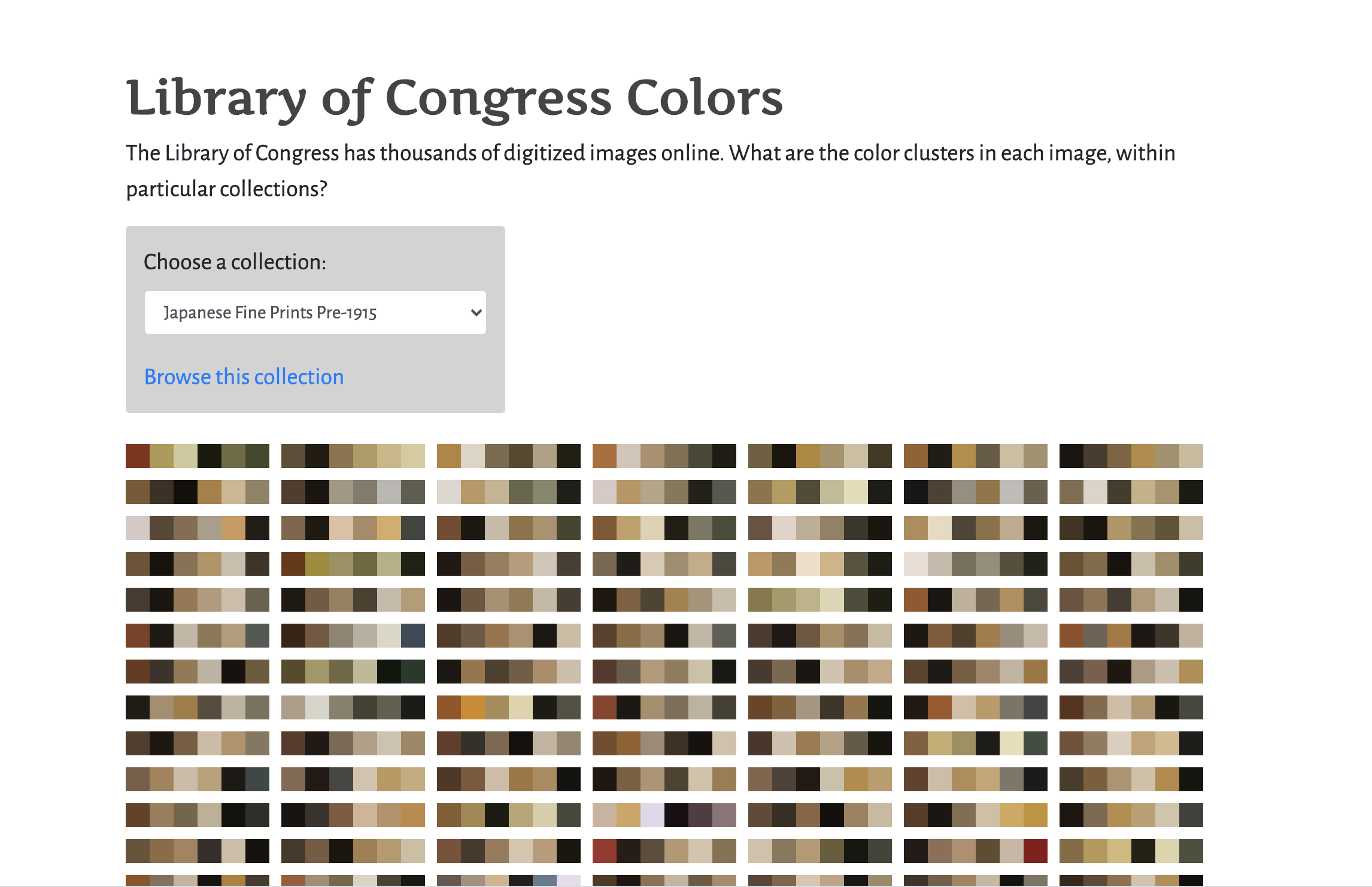
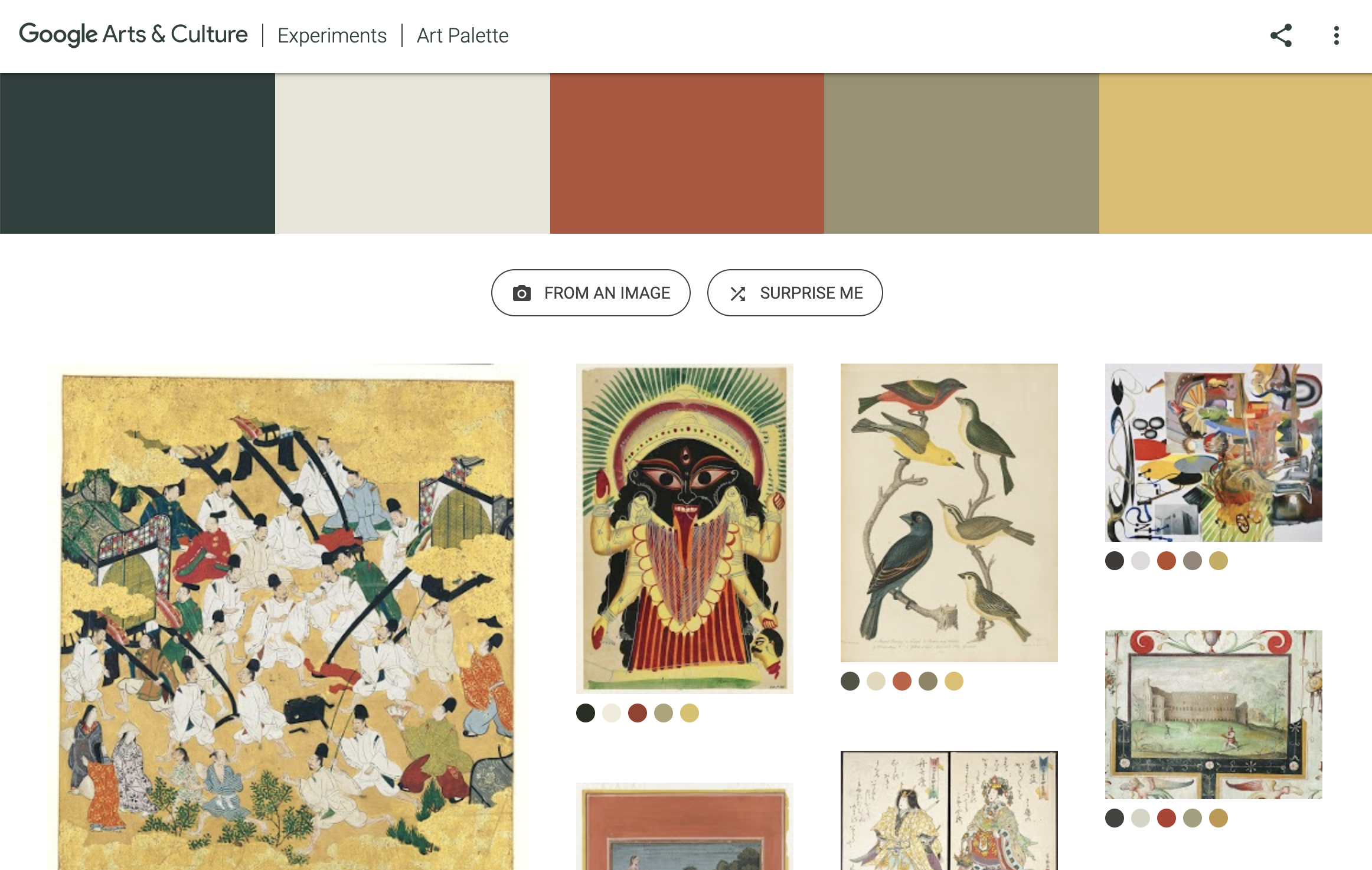
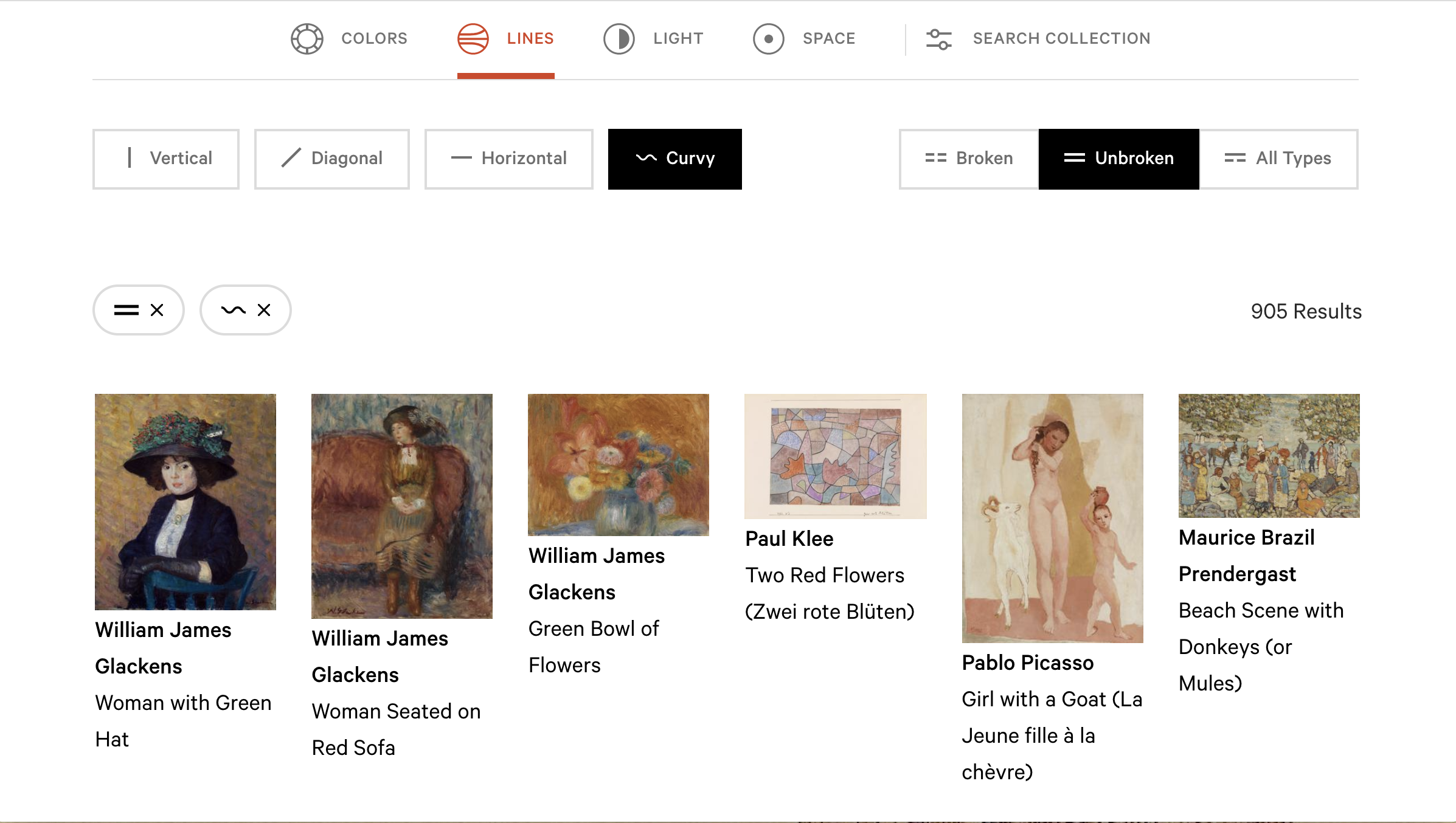
Museums have also taken a more blatant data visualization approach when portraying their online collections. Timelines and histograms are often used, such as the timeline used the Australian Centre for Contemporary Art, or the color histogram for Tate.
博物館在描繪其在線館藏時也采取了更為公然的數據可視化方法。 通常使用時間軸和直方圖,例如時間軸用于澳大利亞當代藝術中心 ,或顏色直方圖用于泰特 。
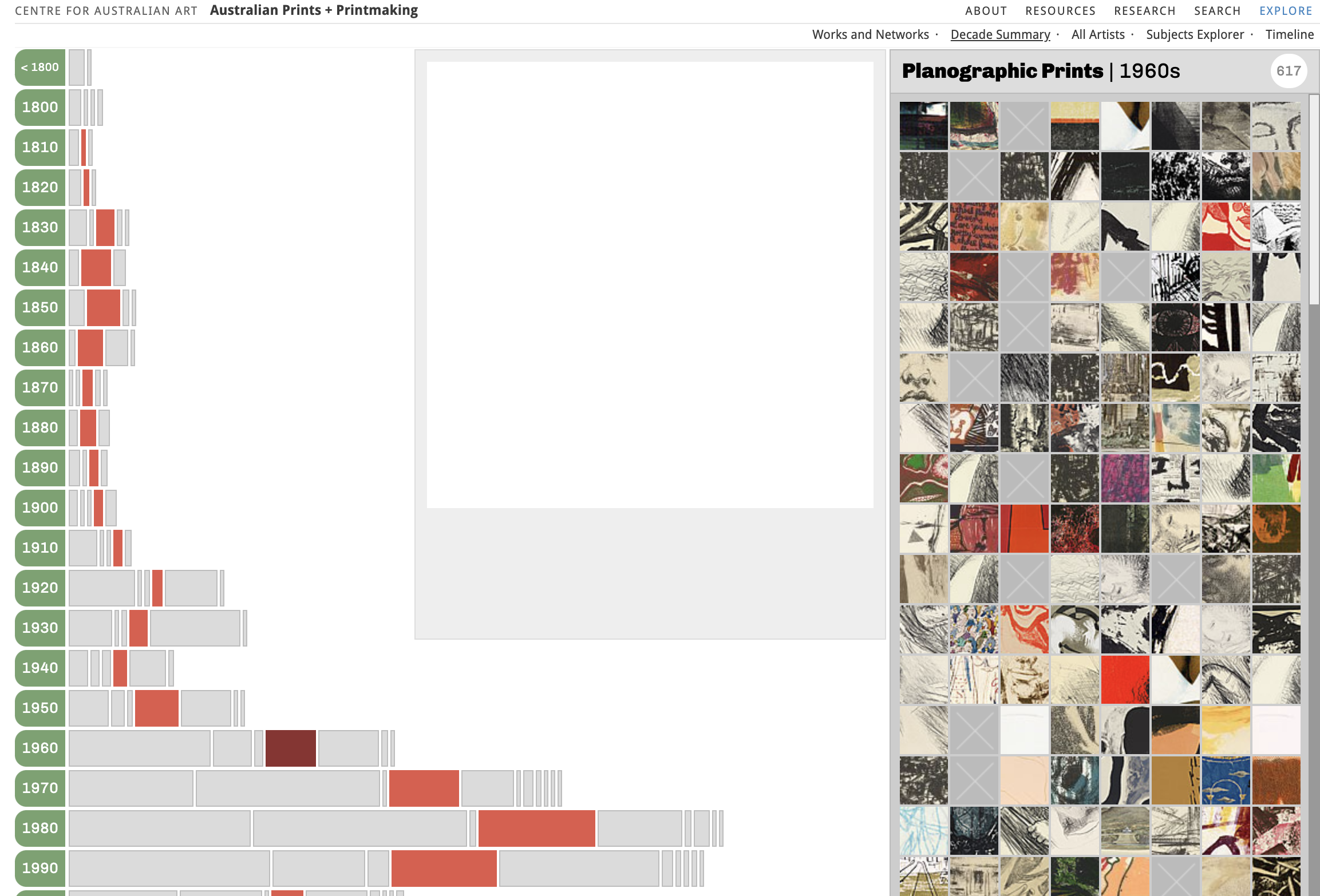
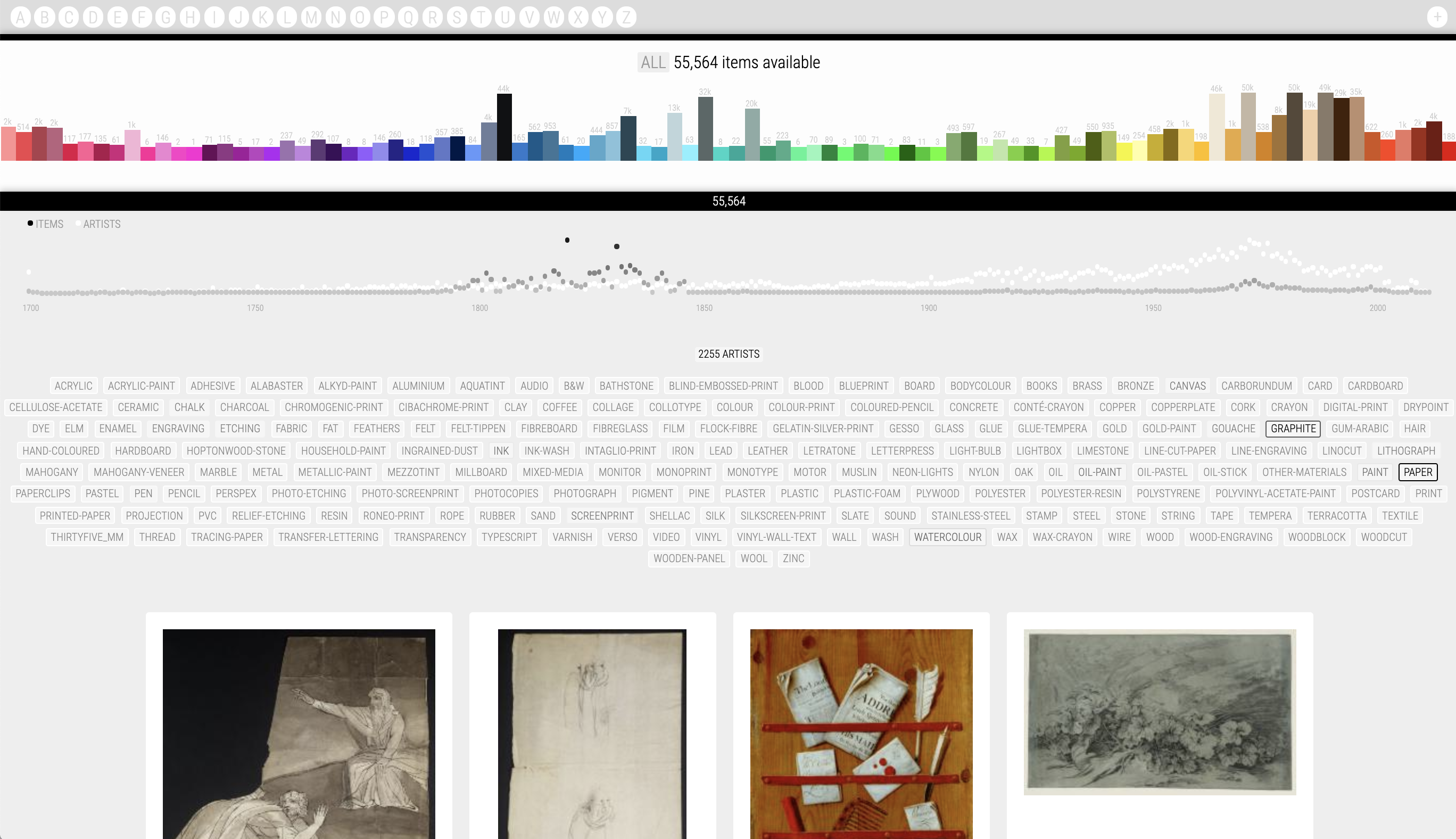
The above experiences seem to be especially suited to the internet and what we can produce from it. Like exhibitions, they weave a curated story that follows a common thread. Showcasing a bare-bones digital collection is convenient for researchers, or those looking for a specific piece, but there’s less “fun” involved for regular visitors — there’s no story thread or focus. Consequently, it’s easy for the viewer to feel overwhelmed and lost. While first steps to develop more interactive digital collections seem to focus on chronology or color, other methods of filtering collections could unfold, such as we saw earlier in “Beyond Scrolls & Screens,” which narrows in on specific objects, illustrating their appearance in each panel. I could also foresee categorizations from mediums used up to the age of the artist when it was produced. You never know what connections you’ll find, unless you try.
以上經驗似乎特別適合于互聯網以及我們可以從中獲得的收益。 像展覽一樣,他們編織的策展故事遵循共同的思路。 對于研究人員或正在尋找特定作品的人來說,展示一個簡單的數字館藏很方便,但是對于普通游客來說,“樂趣”涉及的更少—沒有故事線索或重點。 因此,觀眾很容易感到不知所措和迷路。 雖然開發更多交互式數字館藏的第一步似乎集中在時間順序或顏色上,但是其他過濾館藏的方法可能會展開,例如我們在前面的“超越卷軸和屏幕”中看到的,該圖縮小了特定的對象,說明了它們在每個對象中的外觀。面板。 我還可以預見從使用年代到創作者年齡的各種分類。 除非您嘗試,否則您永遠都不知道會找到什么連接。
My hope is that by digitalizing collections and making them open-sourced, more initiatives such as Experiments with Google and LABS from the Library of Congress will ensue, thus producing unique, digital curated experiences of art. Given the output and initiatives delineated above, it’s clear that data visualization tools have been used for their design, whether or not the developers were aware of it themselves — developers might continue borrowing tools and techniques from data visualization storytelling until their products are one and the same.
我的希望是,通過對館藏進行數字化處理并使其開源化,將會有更多的舉措,例如國會圖書館的Google實驗和LABS實驗,從而產生獨特的,數字化的藝術品策劃體驗。 根據上面描述的結果和計劃,很明顯,無論開發人員是否意識到數據可視化工具已用于他們的設計中,開發人員可能會繼續從數據可視化講故事中借鑒工具和技術,直到他們的產品成為現實。相同。
I expect museums to continue to adopt a digital strategy that embraces interactive visualizations, and even exhibition scrollytelling (like here), which would have suited pages like Southern Mosaic rather well. Such endeavors would not only relieve our boredom when museums are closed but these visualization tools could lead to original narratives during the physical exhibition development process as well.
我希望博物館將繼續采用包含交互式可視化甚至是滾動展覽的數字策略(如此處所示 ),該頁面將很好地適合“ Southern Mosaic”這樣的頁面。 這些努力不僅可以緩解博物館關閉時的無聊感,而且這些可視化工具也可以在實體展覽的開發過程中產生原創性的敘述。
一些數字博物館體驗 (A few digital museum experiences)
For interactive experiences:
對于互動體驗:
The Museum of the World
世界博物館
The Color Hunt
獵色
Beyond Scrolls & Screens
超越卷軸和屏幕
Labs from the Library of Congress
國會圖書館的實驗室
Visualizing Cultural Collections
可視化文化收藏
Audio-based experiences:
基于音頻的體驗:
Digital DJ (says “Coming Summer 2020”)
數字DJ (說“即將到來的2020年夏季”)
The MET audio guides
MET音頻指南
VR Tours:
虛擬現實之旅:
VersailleVR: the Palace is yours
VersailleVR:宮殿在您身邊
The Dawn of Art: a journey through the Chauvet cave.
藝術的黎明:穿越Chauvet洞穴的旅程 。
A good resource for online exhibitions, and tours, to be filtered through at your leisure.
在線展覽和旅游的良好資源 ,您可以隨時通過它過濾掉。

翻譯自: https://medium.com/nightingale/museums-are-going-digital-and-borrowing-from-data-viz-in-the-process-b5e3828b4000
借用繼承
本文來自互聯網用戶投稿,該文觀點僅代表作者本人,不代表本站立場。本站僅提供信息存儲空間服務,不擁有所有權,不承擔相關法律責任。 如若轉載,請注明出處:http://www.pswp.cn/news/389519.shtml 繁體地址,請注明出處:http://hk.pswp.cn/news/389519.shtml 英文地址,請注明出處:http://en.pswp.cn/news/389519.shtml
如若內容造成侵權/違法違規/事實不符,請聯系多彩編程網進行投訴反饋email:809451989@qq.com,一經查實,立即刪除!
![bzoj1095 [ZJOI2007]Hide 捉迷藏](http://pic.xiahunao.cn/bzoj1095 [ZJOI2007]Hide 捉迷藏)




思想及實現)




)

和歸一化實現)


 or ‘1type‘ as a synonym of type is deprecated解決辦法)
轉移方式及參數傳遞)

